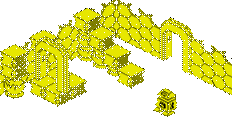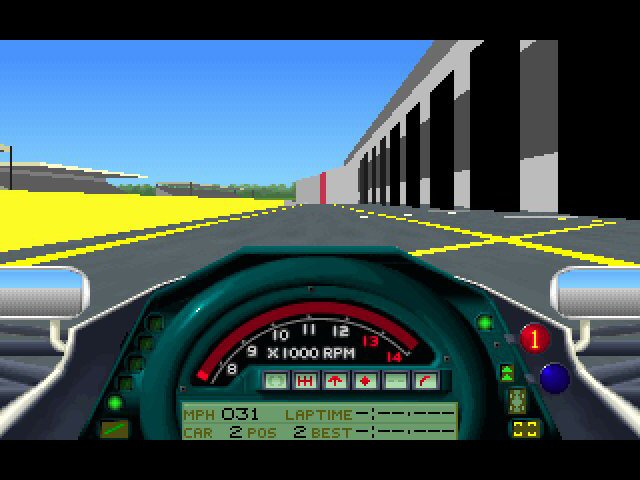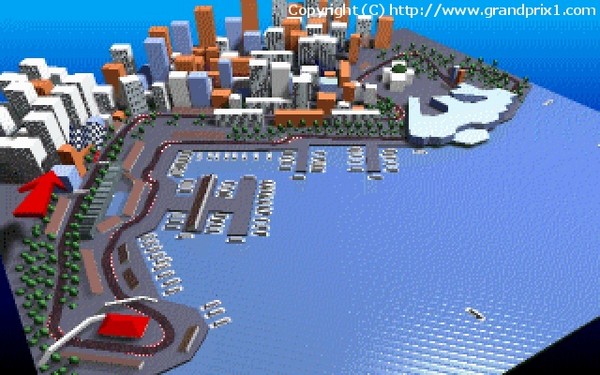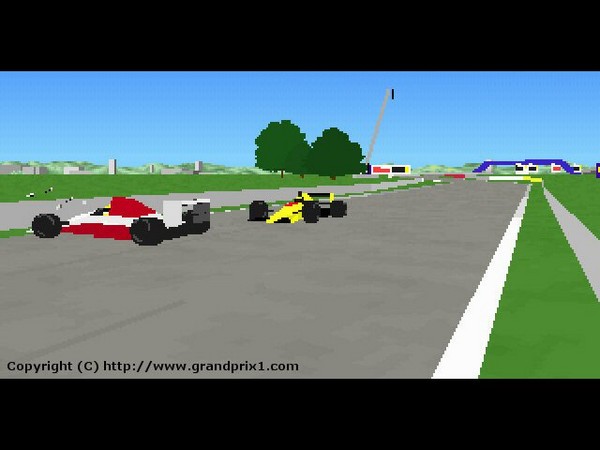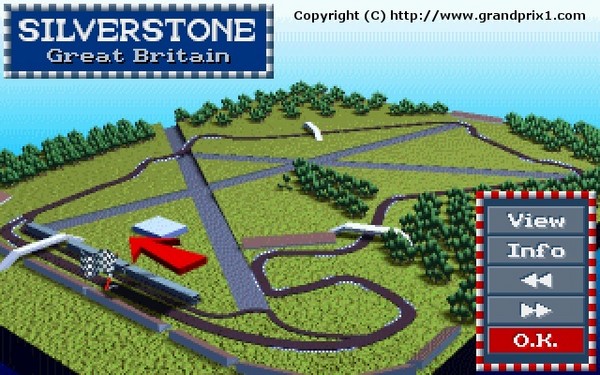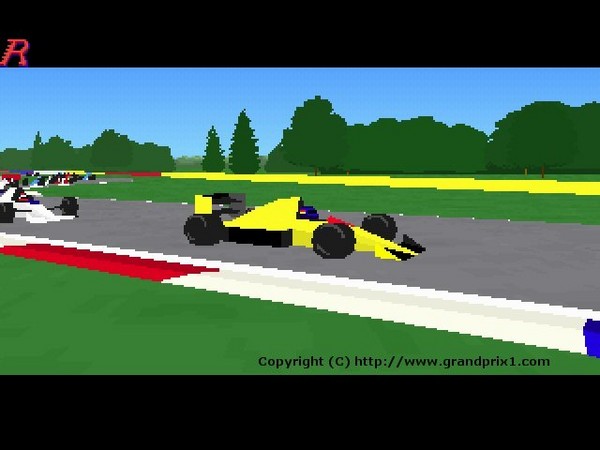Formula One Grand Prix (1991) 
| Details (IBM PC) | Supported platforms | Artwork and Media | |
|---|---|---|---|
| Publisher: Genre: Author(s): Musician(s): Minimum Spec: Recommended Spec: Minimum Memory Required: Maximum Players: Joysticks: Language: Media Code: Media Type: Country of Release: Related Titles: Other Files: Comments: |  Microprose Software Ltd Microprose Software LtdRacing Geoff Crammond - 80286, DOS 5.0, MCGA, HDD with2 MB free 80386, DOS 5.0, VGA, Adlib, Roland or Sound Blaster, HDD with 8 MB free 1 MB 4 Yes Eng 3.5" Floppy Disk UK Grand Prix II Patch v1.05 | Click to choose platform: Atari ST Commodore Amiga IBM PC |
| Videos | Screenshots (IBM PC) |
|---|---|
Please login to submit a screenshot
| Your Reviews |
|---|
 (Anonymous) (Unknown) 23rd May 2011 11:40
(Anonymous) (Unknown) 23rd May 2011 11:40After Papyrus' Indianapolis 500: The Simulation, which was released three years earlier, it was the second serious 3D polygon-based racing sim (that is, without textures, except some for the scenery in the PC version). Geoff Crammond's REVS on the Commodore 64 and BBC home computers used similar polygon-based 3D graphics, but was limited by the relative lack of computer power of the 8-bit machines. Although Indy 500 was strictly speaking first in pioneering many novel features, F1GP would make a bigger overall impression and impact because it featured Formula One race cars, and because it offered the player a complete season to compete in, featuring 16 F1 tracks to Papyrus' 1 track in Indy 500.
When Indy 500 and F1GP appeared, they were the very first to implement something that resembled "real world" racing physics, accurate track modelling and car handling that required skills somewhat similar to real-world driving skills to perform well. Both were also the first to offer meaningful options to tune the behaviour of the cars. Although not quite on the level of later simulations, the most important variables, such as gear ratios, tyre compounds and wing settings were available to tune and, more importantly, proved to make an actual difference when driving. Important were also the functional rearview mirrors and an "instant replay" system with a wide range of adjustable camera settings not seen in other games of the era.
Despite several continuity hiccups, the game offered a completely new experience for players at the time. The accurately modelled tracks meant that the player could actually recognise their location on the real-life circuit. The detailed physics engine provided a more realistic driving experience than had been seen before, drivers could easily experience the differences in handling depending on how you entered a corner and how soon or late you accelerated out of it. Unlike other racing simulations of the time, the accuracy of the simulation actually made the 1/1000 of a second chronometer meaningful, as races could be won or lost by a few thousandths of a second. Vitally, the combination of graphics and physics meant players could actually "feel" whether they were driving fast or slow, and could predict how the car would respond. Even details such as tyre wear were modelled throughout the race, qualifying tyres are an extreme example of this: you could not drive more than a couple of laps without beginning to lose grip and eventually spinning out on nearly every corner. Together with the 16 tracks and the atmosphere-packed rendition of complete Grand Prix weekends, it made F1GP a favourite with Formula One and racing sim fans for many years, and is still referred to occasionally in current reviews as a classic benchmark.
Two more aspects worth mentioning are the "driving help" features, the ability to drive easily with the keyboard or another controller, and the availability of automatic transmission on most cars. F1GP was built on a system that allowed for an almost perfect learning-curve. Depending on which driving assistances were activated, the game covered playability from a pure arcade-racer level up to the most advanced sim-level available at the time. Players could choose to activate innovative help-functions like "brake-assistance" which would apply your brakes in time for a corner, displaying an "ideal line" on the tarmac to help learning the layout of a track, suggestions for the optimum gear, and others. Perhaps the most impressive achievements in that respect were the "steering help" and "throttle assistance". At the time F1GP was released, analogue steering wheels were far from mainstream. Even joysticks were still mostly digital, and in that respect no different from a keyboard. In order to compensate for the strict on-off nature of digital controllers, Geoff Crammond implemented a method to 'smoothen' the inputs. "Throttle assistance" prevented wheel spin when going on the gas. "Steering help" smoothened the steering actions (as an indication, one would experience cars steering slightly into corners all on their own when this help was activated). This was a subtle exercise, as it could give the impression of cars driving themselves when implemented too strongly. As experience showed, a balance was found. Which turned F1GP, and its successors, into a racing game that could be fully enjoyed and played well via digital input devices.
As an aside, it is illustrative for the depth of the game that people actually learned to overcome the need for "Throttle Assistance" when using the keyboard, and discovered that disabling it and applying the right techniques enabled "digital" drivers to go faster (at the expense of tyre wear).
When Indy 500 and F1GP appeared, they were the very first to implement something that resembled "real world" racing physics, accurate track modelling and car handling that required skills somewhat similar to real-world driving skills to perform well. Both were also the first to offer meaningful options to tune the behaviour of the cars. Although not quite on the level of later simulations, the most important variables, such as gear ratios, tyre compounds and wing settings were available to tune and, more importantly, proved to make an actual difference when driving. Important were also the functional rearview mirrors and an "instant replay" system with a wide range of adjustable camera settings not seen in other games of the era.
Despite several continuity hiccups, the game offered a completely new experience for players at the time. The accurately modelled tracks meant that the player could actually recognise their location on the real-life circuit. The detailed physics engine provided a more realistic driving experience than had been seen before, drivers could easily experience the differences in handling depending on how you entered a corner and how soon or late you accelerated out of it. Unlike other racing simulations of the time, the accuracy of the simulation actually made the 1/1000 of a second chronometer meaningful, as races could be won or lost by a few thousandths of a second. Vitally, the combination of graphics and physics meant players could actually "feel" whether they were driving fast or slow, and could predict how the car would respond. Even details such as tyre wear were modelled throughout the race, qualifying tyres are an extreme example of this: you could not drive more than a couple of laps without beginning to lose grip and eventually spinning out on nearly every corner. Together with the 16 tracks and the atmosphere-packed rendition of complete Grand Prix weekends, it made F1GP a favourite with Formula One and racing sim fans for many years, and is still referred to occasionally in current reviews as a classic benchmark.
Two more aspects worth mentioning are the "driving help" features, the ability to drive easily with the keyboard or another controller, and the availability of automatic transmission on most cars. F1GP was built on a system that allowed for an almost perfect learning-curve. Depending on which driving assistances were activated, the game covered playability from a pure arcade-racer level up to the most advanced sim-level available at the time. Players could choose to activate innovative help-functions like "brake-assistance" which would apply your brakes in time for a corner, displaying an "ideal line" on the tarmac to help learning the layout of a track, suggestions for the optimum gear, and others. Perhaps the most impressive achievements in that respect were the "steering help" and "throttle assistance". At the time F1GP was released, analogue steering wheels were far from mainstream. Even joysticks were still mostly digital, and in that respect no different from a keyboard. In order to compensate for the strict on-off nature of digital controllers, Geoff Crammond implemented a method to 'smoothen' the inputs. "Throttle assistance" prevented wheel spin when going on the gas. "Steering help" smoothened the steering actions (as an indication, one would experience cars steering slightly into corners all on their own when this help was activated). This was a subtle exercise, as it could give the impression of cars driving themselves when implemented too strongly. As experience showed, a balance was found. Which turned F1GP, and its successors, into a racing game that could be fully enjoyed and played well via digital input devices.
As an aside, it is illustrative for the depth of the game that people actually learned to overcome the need for "Throttle Assistance" when using the keyboard, and discovered that disabling it and applying the right techniques enabled "digital" drivers to go faster (at the expense of tyre wear).
| Cheats | Trivia |
|---|---|
| There are no cheats on file for this title. | The PC version originally allowed solo races only. In 1993, the v1.05 update added modem support and a few other improvements. |
History
This title was first added on 2nd May 2010
This title was most recently updated on 15th May 2015

